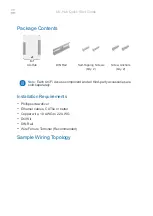
Installation manual: OASiS security system JA-82KRC-US
13 / 21
MKH51400
•
If the unconfirmed entrance delay is confirmed by an instant
detector it will trigger an internal warning alarm immediately
(e.g. an internal siren) and if the entrance delay times out
then an external alarm will be triggered.
•
An unconfirmed alarm can be confirmed by any other intruder
detectors in the system as long as the detectors are assigned
to a set (armed) section.
•
The confirmation of intruder alarms has no effect on fire,
panic, 24-hour, tamper, or technical alarms. These alarms are
triggered immediately without confirmation.
Note:
When the first detector is triggered it begins a process
which waits 40 minutes for any possible confirmation of the
alarm (unconfirmed alarm status) during which the system works
exactly the same way as if the confirmation function had not
been enabled.
Warning:
If intruder alarm confirmation is enabled, it is
necessary to install enough detectors in the building to detect an
intruder even if he/she is only moving in one particular place.
Factory default setting:
confirmation disabled
12.16. Exit delay beeps
The exit delay can be indicated by beeps from the keypad and
internal siren. The beeps get faster in the last 5 seconds.
3 3 1
Beeps
enabled
3 3 0
Beeps
disabled
Factory default setting:
Beeps enabled.
12.17. Exit delay beeps while partially setting
(arming)
The exit delay caused by partial setting, e.g. using the A or B
key, can also be indicated by keypad beeps and internal-siren
beeps. The beeps get faster in the last 5 seconds. The feature is
linked to 33x setting.
3 4 1
Beeps
enabled
3 4 0
Beeps
disabled
Factory default setting:
Beeps disabled.
12.18. Entrance delay beeps
The entrance delay can be indicated by keypad beeps and
internal-siren beeps:
3 5 1
Beeps
enabled
3 5 0
Beeps
disabled
Factory default setting:
Beeps enabled.
12.19. Setting (arming) confirmation by wired-siren
chirp
A hard-wired siren connected to the IW terminal of the control
panel can audibly indicate setting by one beep, unsetting by two
beeps and unsetting after an alarm by three beeps. Four beeps
mean an invalid attempt at setting the system has occurred.
3 6 1
Chirps
enabled
3 6 0
Chirps
disabled
Note:
In JA-80L wireless sirens, this function can be individually
enabled for each siren. (see the siren manual).
Factory default setting:
Hard-wired siren chirps disabled
12.20. Sirens always sound during audible alarms
Using this sequence it is possible to disable internal and
external sirens (IW and EW) if any part of the system is unset
(partial setting), i.e. when someone is home.
3 7 1
Sirens always sound during audible alarms
3 7 0
Sirens only sound during audible alarms when
all sections are set, i.e. no one is home
Factory default setting:
Sirens always sound during audible
alarms.
12.21. Wireless siren alarm enabled (IW and EW)
This setting is for enabling and disabling wireless sirens in the
system:
3 8 1
wireless sirens enabled
3 8 0
wireless sirens disabled
Note:
This setting has no effect on wired output terminals.
Factory default setting:
wireless sirens enabled
12.22. Auto-bypass user approval via the
∗
∗
∗
∗
key
The system has a built-in auto-bypass function so that if any
number of detectors are being triggered during setting (arming)
then they will be bypassed and ignored automatically.
If auto-bypass approval by the user is disabled, then during
setting (arming) the system notes which detectors are currently
triggered and automatically bypasses them without consulting
the user.
If however, auto-bypass user approval is enabled, then during
setting (arming), the system notes which detectors are currently
triggered and displays informative text on the keypad and only
bypasses them if the user approves the bypassing by keying in a
∗
within 6 seconds of being notified.
3 9 1
Approval is requested from the user
3 9 0
Bypassing occurs automatically without user
approval
Notes regarding setting the system with (a) triggered detector(s):
•
Details on currently triggered detectors can be viewed by
pressing the
?
key (e.g. open doors or windows).
•
If a wireless keyfob is used to set the system and auto-
bypass user approval is enabled, the system will set without
bypass approval, i.e. setting by keyfob does not trigger an
approval request.
•
The automatic bypass of a detector will end after the detector
has been de-triggered (for example if a door is closed)
•
If auto-bypass user approval is enabled and Service mode is
being exited while a detector is being triggered, the installer
will be notified about the bypass. The installer can then
approve the bypass by pressing # twice.
•
To comply with the EN-50131-1standard 391 should be set.
Factory default setting:
Bypassing occurs automatically
without user approval.
12.23. Final-door detectors
In this mode, up to 5 detectors can be defined as final-door
detectors and assigned to addresses 01 to 05 or 46 to 50 in
order to make leaving a building much easier, especially via a
garage:
65x
where
x = 0
none,
x = 1
detectors on addresses 01 to 05,
x = 2
detectors on addresses 46 to 50.
Description of final-door detector mode:
•
If a final-door detector is used in the system then the value of
x for exit delay programming is multiplied by 30 s (see 12.1)
thereby extending the delay, and if an entrance delay is
triggered by a final-door detector then the value of x for the
entrance delay is also multiplied by a larger value of 30 s.
•
A final-door detector should be programmed to have a natural
reaction.
•
Door/window detectors, hard-wired control panel inputs or
hard-wired inputs in the wireless keypad unit can be used as
final-door detectors.
•
If a final-door detector is used for a garage door, no instant
detectors should be inside the garage. Next-delay detectors
would however be acceptable.
Setting (arming) the system with a final-door detector:







































